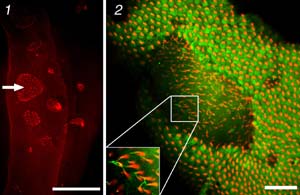Articles and reports from the Life Sciences and chemistry area deal with applied and basic research into modern biology, chemistry and human medicine.
Valuable information can be found on a range of life sciences fields including bacteriology, biochemistry, bionics, bioinformatics, biophysics, biotechnology, genetics, geobotany, human biology, marine biology, microbiology, molecular biology, cellular biology, zoology, bioinorganic chemistry, microchemistry and environmental chemistry.

Purdue University biologists have learned how to control the development of stem cells in the inner ears of embryonic chickens, a discovery which could potentially improve the ability to treat human diseases that cause deafness and vertigo.
By introducing new genes into the cell nuclei, researchers instructed the embryonic cells to develop into different adult cells than they would have ordinarily. Instead of forming the tiny hairs that the inner ear uses to detect sound waves, the stem cell

New research from the University of North Carolina at Chapel Hill has identified a cellular enzyme that helps regulate the synthesis of proteins essential to cell functioning throughout the life of the organism. The enzyme binds to histone messenger RNA, which is DNA’s blueprint for histone protein synthesis.
As histones represent about half of the nucleoprotein complex known as chromatin, they are vital to DNA replication and the subsequent assembly of chromosomes A report of the rese

A cellular protein identified by scientists at the University of North Carolina at Chapel Hill may be the crucial molecular element for gene silencing.
The research findings, published Aug. 29 in the science journal Molecular Cell, add important knowledge to the understanding of epigenetic signals. These chemical signals affect the modulation of gene expression – activation or repression – throughout the genome.
Studies at UNC and elsewhere have shown that epigenetic phenomena unde

Identifying the structures of certain types of molecular compounds can now take minutes, instead of days, and be performed much more accurately, say scientists who developed a new approach for analyzing key experimental X-ray data.
Knowing the structure of a molecule allows scientists to predict its properties and behavior. While X-ray diffraction measurements have become a powerful tool for determining molecular structure, identifying the three-dimensional structure that best fits the diff

On October 13, 2003 the European Bioinformatics Institute (EBI) will launch a new bioinformatics support network that is tailor-made for small companies.
It can be a lonely business being a bioinformatician in a small company. It is widely acknowledged that Europe’’s economic development is becoming increasingly dependent on small-to-medium enterprises, or SMEs (enterprises with fewer than 250 employees and an annual turnover not exceeding 50 million Euros or an annual bala

Probably, animals and human beings possess a biochemical vehicle for measuring life span. The key role in this vehicle is played by a short DNA – chronomere. The chronomeric ageing theory, based on tremendous experimental material, has been developed with support of the Russian Foundation for Basic Research.
Early in the 70s of the 20th century, Russian researcher Alexy Olovnikov forecast existence of the chromosomes’’ end sequences – telomer, which shorten after each cell division